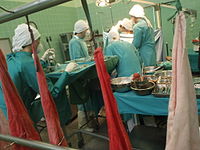
Photo from wikipedia
Background Heart transplantation from donation after circulatory (DCD) death donors is now recognized as a viable strategy to expand the donor pool. DCD adult heart transplantation with distant procurement has… Click to show full abstract
Background Heart transplantation from donation after circulatory (DCD) death donors is now recognized as a viable strategy to expand the donor pool. DCD adult heart transplantation with distant procurement has been established in multiple centres in the UK and is also practiced in Australia. In addition, DCD heart transplantation in the paediatric population has been practiced in the USA with promising results. The world's largest single centre experience of adult DCD heart transplantation is reported. Methods Donation after circulatory death hearts were retrieved from Maastricht III donors using established DCD heart procurement techniques of either Direct Procurement and Perfusion (DPP) or Normothermic Regional Perfusion (NRP) between February 2015 and March 2018. Distant procurement was enabled with the use of continuous machine perfusion. Inclusion criteria for suitable donors included the use of only a single inotropic agent at the time of withdrawal of life supportive therapy (WLST) and an echocardiogram demonstrating an ejection fraction of greater than 50% with no structural abnormalities. The time allowed for circulatory cessation was initially limited to 3 hours and subsequently extended to 4 hours. Primary outcomes included 30-day survival, length of stay on intensive care and length of stay in hospital. Secondary out-comes included the use of post-operative mechanical circulatory support with an intra-aortic balloon pump (IABP), ECMO or ventricular assist device. Results During the 37-month study, 44 DCD hearts were transplanted. The median donor age was 36 years and the median recipient age was 57.5 years. Thirty-day survival was 100% and survival to discharge from hospital was 95%. The median length of stay on intensive care was 5 days with a median hospital stay of 20 days. A post-operative IABP was used in 9 patients (20%) with 5 patients (11%) requiring ECMO support. Twenty-eight patients have been followed up for one year post-transplant with a 1-year survival of 86%. Conclusions Heart transplantation can be safely undertaken utilizing organs from DCD donors and is associated with excellent early clinical outcomes. The use of DCD heart donors increased local transplant activity by more than 35% over the 3-year period. Adoption of clinical programs of DCD heart transplantation in North America may allow for a similar increase in heart transplant activity.
Journal Title: Journal of Cardiac Failure
Year Published: 2018
Link to full text (if available)
Share on Social Media: Sign Up to like & get
recommendations!